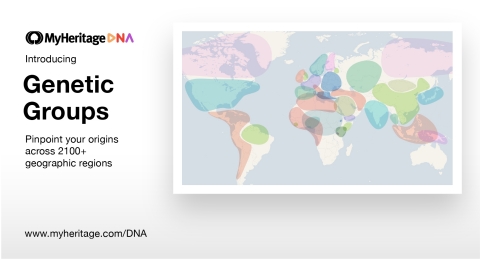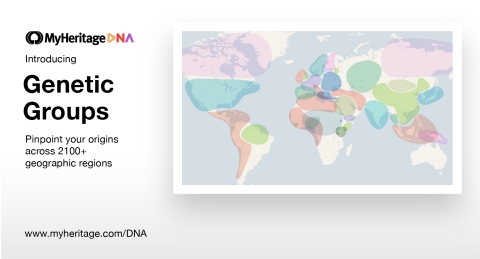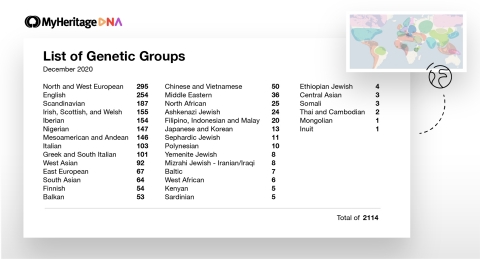TEL AVIV, Israel & LEHI, Utah--(BUSINESS WIRE)--MyHeritage, the leading global service for discovering your past and empowering your future, announced today the release of Genetic Groups. A major enhancement to MyHeritage DNA’s ethnicity estimates, Genetic Groups accurately identify ancestral origins with an incredibly high resolution of 2100 geographic regions, more than any other DNA test on the market. As of today, Genetic Groups form a key part of MyHeritage DNA test results and are included free of charge for all new and existing MyHeritage DNA customers.
Genetic Groups provide greater granularity than standard ethnicity breakdowns by segmenting larger ethnic groups, such as Scandinavians, into smaller groups that share a common historical background. Populations that lived together for centuries, originating in the same small locations or migrating together to new lands, often formed unique genetic signatures. The MyHeritage DNA test detects these signatures among people who descend from these groups.
For example, beyond learning that they have Scandinavian origins, a user can now find out that they are Danish. Not only that, but they may now learn where exactly in Denmark their ancestors came from, including locations such as the Faroe Islands or Western Greenland; or, they may find that their ancestors were Danish settlers in Minnesota. These are just a few of the 187 Genetic Groups that MyHeritage detects from Scandinavia, and the 54 Genetic Groups from neighboring Finland.
While some Genetic Groups draw on a specific ethnicity and are further refined into smaller geographic regions, others consist of populations from diverse ethnic backgrounds that migrated to the same region. For example, a Genetic Group in Australia may consist of individuals whose ancestors originated in England and Germany, but after migrating to the same city became a melting pot and created a new group of their own.
“We are truly excited to bring Genetic Groups to MyHeritage users and the passionate community of genetic genealogy, as a wonderful new tool for tracing family history,” said Gilad Japhet, Founder and CEO of MyHeritage. “Being the international market leader in consumer DNA testing, especially in Europe, allowed us to develop this fascinating feature, which will help millions of people learn more about their origins with exceptional depth and resolution. Genetic Groups provide us with new insights and a renewed appreciation for our ancestors, the paths they traveled, and the lives they lived, to make all of us who we are today.”
The MyHeritage Science, R&D, and Product teams spent three years aggregating and analyzing massive data sets to bring this project to fruition. They examined the DNA matches within a huge reference panel of 1.7 million DNA kits on MyHeritage and developed algorithms to cluster the DNA kits into groups based on millions of DNA microsegments, inherited from each group’s founding mothers and fathers. The presence of these telltale segments allows MyHeritage to accurately predict which Genetic Groups DNA test takers descend from, often down to the country and city level. Two million additional DNA kits that were not part of the reference set were then used to validate the accuracy of the Genetic Groups. The research involved fascinating work by MyHeritage scientists and engineers to classify the identity of each group. By leveraging aggregated ancestral metadata from the family trees associated with the DNA kits in the reference set, together with the genetic ethnicity results of the group members, MyHeritage revealed and documented each group’s unique story. This process included multiple iterations of fine-tuning, merging, and splitting of similar groups, and at its completion more than 2100 distinct Genetic Groups emerged.
The outstanding resolution of Genetic Groups and the innovative technology that powers this feature mean that MyHeritage is now able to identify many populations that have never hitherto been detected by any consumer DNA test. For example, descendants of the ancient Jewish communities of Aleppo in Syria, or Tripoli in Libya, can now trace their origins among 55 different Jewish groups supported by MyHeritage. Another population with fascinating history is the Volga Germans — this group is composed of descendants of German settlers who migrated to the Volga River region of Russia and whose descendants later moved to Ellis County in Kansas and other locations. MyHeritage can identify 9 distinct Genetic Groups of Volga Germans. More examples of groups that are unique to MyHeritage include Norwegians from Kvam and Bergen and their descendants in Minnesota, Italians from Potenza and Basilicata and their descendants in the United States, and hundreds more. The richness of MyHeritage’s Genetic Groups eclipses the competition, primarily for European origins, as MyHeritage is the genealogy and DNA market leader in Europe. For example, whereas some competing products may identify a small handful of regions from Italy, MyHeritage supports 103 Italian regions, which is a boon for anyone with Italian roots. MyHeritage also shines in South America, where it detects 146 Genetic Groups, including many indigenous populations. African-American and Native American populations are represented too.
Membership in a Genetic Group is binary; an individual is either a member, or they are not, and in contrast to ethnicities, the groups do not come with percentages. Instead, MyHeritage assigns each Genetic Group a confidence level that is based on the number of DNA segments a person has in common with those that define a specific group. This confidence level reflects the quality and quantity of DNA segments that a person shares with the genetic data that represents each group.
The Genetic Groups feature includes detailed genealogical insights about each group. Users can view a group's migration patterns and drill down to view its precise whereabouts during different time periods from the 17th century until today. For each Genetic Group, users can view common ancestral surnames and common given names, the most prevalent ethnicities among the group's members, a list of other groups that have high affinity to the current one, and more.
Genetic Groups are available for free to anyone who has already taken a MyHeritage DNA test, as an enhancement to the ethnicity estimate. Users who have previously uploaded DNA results to MyHeritage from another service and have access to advanced DNA features (including those who uploaded before December 16, 2018 and have been grandfathered in), or who have an active subscription, will likewise be able to access Genetic Groups at no added cost. Users who have uploaded DNA results from another service and do not currently have access to advanced DNA features may pay a one-time unlock fee of $29 per kit to view their Genetic Groups and much more. Users who have taken a DNA test with another service are welcome to upload their results to MyHeritage and unlock access to their Genetic Groups, which will be calculated for them overnight.
Genetic Groups complement MyHeritage’s percentage-based ethnicity estimates, which are based on 42 ethnicities. The percentage-based ethnicities were not changed in this update and MyHeritage is currently working on replacing them with better technology, which will be released separately during 2021.
About MyHeritage
MyHeritage is the leading global discovery platform for exploring family history. With billions of historical records and family tree profiles, and with sophisticated matching technologies that work across all its assets, MyHeritage allows users to discover their past and empower their future. Launched in 2016, MyHeritage DNA has become one of the world’s largest consumer DNA databases, with more than 4.5 million customers. Since 2020, MyHeritage is home to the world’s best technologies for enhancing and colorizing historical photos. MyHeritage is the most popular DNA test and family history service in Europe. www.myheritage.com



